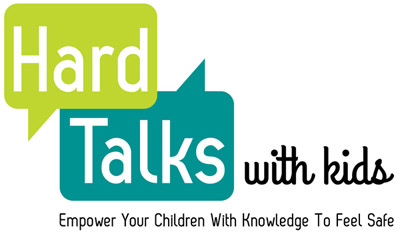

Anxiety at School Drop-off – What’s Normal? by Dr. Dawn Huebner
hard talks November 4, 2016 admin 1

Subscribe to Hard Talks With Kids
“I don’t want to go to school!”
Sometimes it’s as direct as that. Other times it’s more subtle. Clinging. Crying. Sleep issues. Stomach aches. The nervous chewing of collars.
Separation anxiety comes in many forms, all based on the reluctance (read: extreme reluctance) to leave a major attachment figure. What drives this is the fear that the parent will be needed, or missed, or that something will go wrong, very wrong, and the parent won’t be there to help. It’s normal for kids to feel this way. In fact, an utter lack of separation anxiety is sometimes a sign of insufficient attachment. But still, too much separation anxiety is a problem, making mornings difficult (to say the least) and preventing children from moving off into the world and accumulating the experiences that help them learn and grow.
So how much is too much? Separation reluctance is normal in young elementary school children. Hesitancy. Some tears. The need to be reassured, and maybe diverted by a supportive teacher. This usual sorts itself out several weeks into the school year as children get attached to their teacher and accustomed to new routines. When the problem persists, when night times are hard and mornings are hard and the peeling off of little fingers become routine, it’s time to take action.
Actually, it would be best to take action before then, but often problems aren’t evident until they are suddenly EVIDENT. You haven’t done anything wrong or missed anything big. That’s just the way it is.
But if you find yourself 6 or 8 weeks into the school year with a child still having trouble adjusting, it’s unlikely that the problem will go away on its own. Here are some things you can do:
- Make sure your child is getting enough sleep. We live in a nation that does not prioritize sleep. As a result, many of us are sleep-deprived, including children. Young children need 10-11 hours of sleep. Some need even more. You know your child is getting enough sleep when she wakes up on her own (not with you waking her, not due to house noise) in good spirits, clearly rested and refreshed. If your child takes a long time to fall asleep, is extremely restless in sleep, snores, has multiple nighttime awakenings or is hard to wake up in the morning, talk to your doctor. Start the bedtime routine early. Keep it consistent. Unless you co-sleep as a parenting philosophy, expect your child to fall asleep – and stay asleep – alone.
- Unless you co-sleep as a philosophy, expect your child to fall asleep – and stay asleep – alone. This is a biggie. Children with separation issues are often clingy at other times, as well, including bedtime. Teaching your child to sleep alone will help him learn to navigate daytime separations, too. Create a bedtime routine that includes closeness and cuddling. Reading while snuggled together in a cozy chair or your child’s bed is perfect. Read. Perhaps sing a song, or say a prayer, or do a special night-night, and then leave. Do not stay with your child until he falls asleep. If you are already in the habit of staying, perhaps falling asleep in your child’s room yourself, you will need to wean your child from your presence. Actually, ‘wean’ is perhaps misleading as it implies a gradual withdrawal, which is hard to do. Children who know their parents are leaving remain vigilant, not allowing themselves to relax into sleep. It is better to do your nice routine and then leave, while your child is fully awake (no sneaking out – that defeats the purpose of this). Check back in with him often, but just a quick check in the doorway, no additional stories or songs or cuddles. Reward your child for staying in bed quietly. Expect it to take several weeks of determined effort for your child to learn to fall asleep without you there so even if the first few nights are disastrous, hang in there. The ability to self-soothe and relax enough to fall asleep alone is tremendously important, strengthening coping skills and self-reliance that will help your child in the daytime, too.
- Make sure your child is able to navigate your house alone. Again, this is a way you (and she) can practice mini-separations – potentially many times a day – and it will make it easier for your child to say goodbye when it comes time for school. If your child cannot be in a room alone (follows you, calls out to you, asks you to accompany her), start practicing alone-time in a specific way. Have your child play alone in a room – knowing she is doing that – without calling out to you or coming to find you, first for 5-minutes, then 10-minutes, then 15-minutes, and so on, aiming for the ability to play alone for 30-minutes without checking in with you (increase time slowly). Play games with your child that force her to separate, then return. Perhaps hide a stuffed animal in a remote part of the house and have her go find it (alone). Send her on little excursions: go count all the doorknobs and drawer knobs; draw a picture of something in each room (for you to later guess); find things that you’ve hidden; set up a stuffed animal zoo (complete with stuffed animals and cages) that you will later visit. The goal is to have your child leave you, and then return, leave you and then return, over and over again. It’s like an older child version of peek-a-boo, reassuring your child at a deep level that the anxiety of separation is temporary, and that she is, in fact, okay on her own.
- Crying upon separation can start out as genuine, and then take on an automatic quality becoming, essentially, a habit. Help your child change this habit. Work out a new script, and teach it to your child in a very explicit way. Be supportive about this, and make it fun. Tell your child, “I’ve noticed that saying goodbye is really hard for you. I understand that; I miss you, too. But I know we’re going to see each other at the end of the day, and I look forward to hearing about all the fun things you’ve done, so let’s figure out a more fun way to say goodbye.” You might put a kiss into your child’s hand, and have her kiss yours. You might do butterfly kisses (fluttering your eyelashes against each other’s). You might do “See you later, Alligator” (there are all sorts of fun responses to this – look them up online), or tell a Knock-Knock joke. Teach your child a goodbye protocol, or script, practice it, and then stick with it, at least on your end. If your child starts to deviate from the script, remind her, “Uht, uht, that’s not the script.” Reward her for following the script. A grab bag with slips of paper describing small treats is a compelling reward, things like: Mom will carry your backpack home; double-dessert tonight; War tournament after dinner; piggy-back ride to bed; tickle-fight after school; stop at the park on the way home – small but out-of-the-ordinary things your child can look forward to. You might say that if your child goes through the goodbye script without extra fussing and tears, he can reach into the grab-bag either right before leaving or as soon as he sees you at the end of the day.
- Acknowledge your child’s sadness or worry, and help her develop tools to deal with it. It isn’t enough to simply reassure your child. She needs to learn how to help herself when she feels this way. Work out with your child something she can DO when she feels sad or lonely. Maybe she can squeeze a small comfort item she has in her pocket, or finger a necklace you’ve given her. Maybe she can put a little mark on a piece of paper, which you will later look at and talk to her about. Teach her to talk to herself, reminding herself that she’s okay, and that she’ll see you later. Teach her to refocus on what her class is doing, or on something fun coming up (recess or art or whatever your child most enjoys). Involve your child’s teacher in this so that adults throughout her day are coaching her to use her tools to help herself.
- Seek out self-help materials. Again, the goal is to help your child build skills. You can’t just wipe out your child’s feelings – sadness or nervousness or uncertainty – but you can teach him skills to more effectively cope with these feelings, reducing their impact on him. Children who feel able to cope move into the world in more self-assured ways.
- If you find yourself several months into a school year and your child is still struggling significantly, or if at any time, problems are starting to affect your child globally (affecting sleep, appetite, the ability to take part in activities), seek professional guidance. A licensed therapist (psychologist or social worker) can evaluate the situation and make recommendations. If therapy is recommended, look for a skill-focused approach, one that will teach your child coping skills to help him better navigate new situations and difficult feelings.
Dr. Dawn Huebner is the author of the What to Do Guides for Kids published by the American Psychological Association’s Magination Press. With over 800,000 copies sold, her books have been translated into 12 languages and featured on The Today Show, WebMD, Parents Magazine and other news and media outlets. She gave a TEDx talk on Re-Thinking Anxiety, and is a popular speaker for both parenting and professional groups. Dr. Huebner received her PhD in Clinical Psychology from The University of Michigan in 1987. She worked as an Assistant Professor of Pediatrics at the Medical College of Ohio and Henry Ford Hospital prior to moving to NH. Dr. Huebner now specializes in the treatment of anxious children ages 12 and under and their parents, translating cognitive-behavioral techniques into easy-to-follow steps. Dr. Huebner is a member of the APA, the NH Psychological Association, the Anxiety Disorders Association of America, the International OCD Foundation, and the Society of Children’s Book Writers and Illustrators, and is a BTTI graduate (certified in the treatment of OCD). An updated list of books and information about her practice is available on her website: www.DawnHuebnerPhD.com.
Receive updates from Hard Talks With Kids

sabung ayam online
June 21, 2017 #1 AuthorI love it when folks come together and share thoughts. Great site, continue the good work!